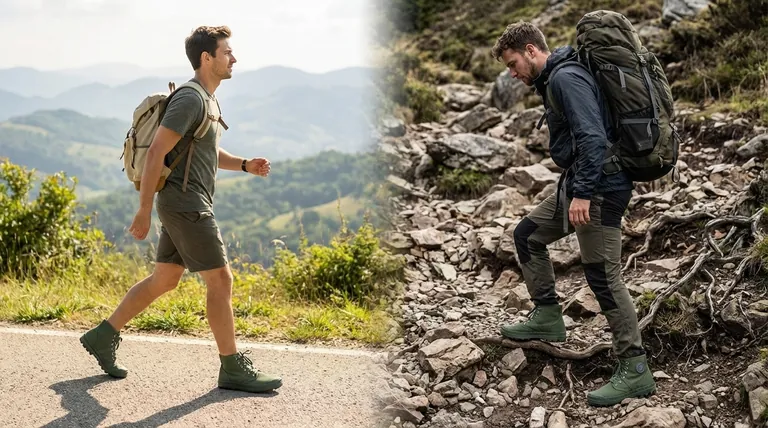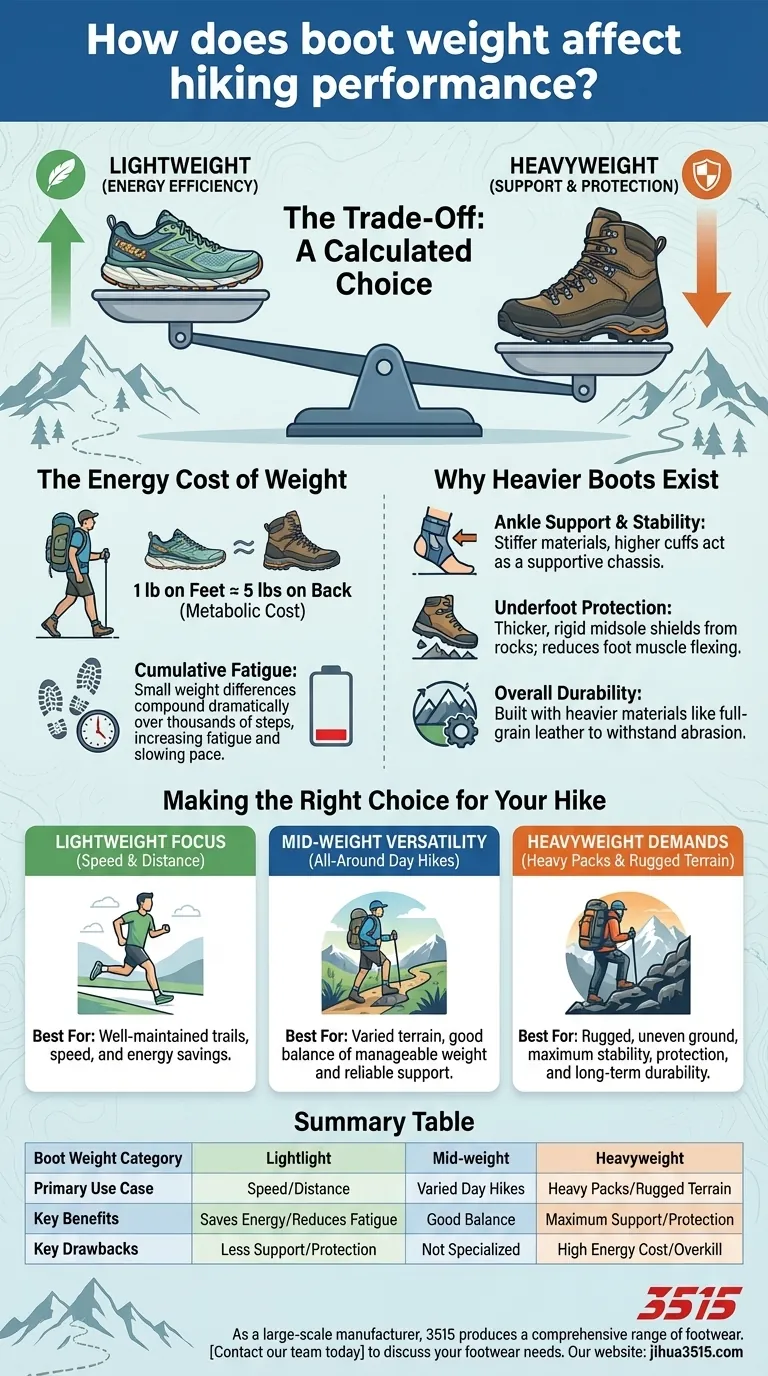Boot weight is one of the most critical factors in hiking performance. The long-held wisdom states that one pound on your feet is equivalent to carrying five pounds on your back. Lighter boots significantly reduce the energy you expend and the fatigue you feel over a long day. However, that weight serves a purpose, providing crucial support, protection, and durability that lighter footwear often lacks.
The core issue is not simply "light vs. heavy." It's understanding that boot weight is a direct proxy for construction. The choice is a calculated trade-off between the energy savings of a lighter boot and the stability and protection of a heavier one, which must be matched to the demands of your hike.

The Energy Cost of Weight
The most immediate impact of boot weight is on your energy reserves. Every step requires you to lift your footwear, and small differences in weight compound dramatically over a long distance.
The "Five Pounds on Your Back" Rule
This classic backpacking rule highlights the disproportionate metabolic cost of weight on your feet. Lifting your legs is a primary mechanical action in hiking. Adding weight to the end of that lever requires significantly more energy than adding the same weight to your stable torso.
Cumulative Fatigue
The difference between a 1 lb boot and a 2 lb boot may seem trivial at first. But after 20,000 steps, you have effectively lifted an extra 10 tons over the course of your day. This directly translates to increased fatigue, slower pace, and less energy for the final miles.
Why Heavier Boots Exist: Support and Protection
If lighter were always better, heavy boots wouldn't exist. Their weight is a byproduct of features designed to protect your feet and ankles on challenging terrain.
Ankle Support and Stability
Heavier boots almost always feature stiffer materials and higher cuffs. This robust construction acts as a supportive chassis for your foot and ankle, preventing twists and rolls when navigating rocky, uneven ground, especially when carrying a heavy pack.
Underfoot Protection
Weight is also a sign of a thicker, more rigid midsole and outsole. This robust platform shields your feet from sharp rocks and roots, preventing bruising. It also reduces the constant flexing of your foot muscles, which is a major source of foot fatigue on long hikes.
Overall Durability
Heavier materials, such as full-grain leather and thick rubber rands, are inherently more durable. A heavier boot is an investment in longevity and is built to withstand the abrasion and abuse of off-trail scrambling and rugged mountain environments.
Understanding the Trade-offs
The ideal boot is not the lightest possible option; it's the lightest option that still meets the support and protection demands of your specific objective.
The Myth of "Lighter is Always Better"
Choosing an ultralight trail runner for a multi-day trek with a 40-pound pack in the mountains is a mistake. The lack of support can lead to foot fatigue, and the minimal protection increases the risk of a trip-ending ankle injury.
The Burden of "Too Much Boot"
Conversely, wearing a heavy-duty mountaineering boot for a casual walk on a flat, groomed trail is inefficient. You are paying a high energy penalty for support and durability features you simply do not need, leading to unnecessary fatigue.
Making the Right Choice for Your Hike
Select your footwear based on the terrain, the weight of your pack, and your own physical needs.
- If your primary focus is speed and distance on well-maintained trails: A lightweight hiking shoe or trail runner will provide the best energy savings.
- If your primary focus is carrying a heavy pack over rugged, uneven terrain: A heavier, more supportive boot is essential for stability, protection, and long-term durability.
- If your primary focus is all-around versatility for varied day hikes: A mid-weight boot offers the most effective balance of manageable weight and reliable support.
Ultimately, choosing the right boot weight is about giving your feet the exact tool they need for the job ahead.
Summary Table:
| Boot Weight Category | Primary Use Case | Key Benefits | Key Drawbacks |
|---|---|---|---|
| Lightweight | Speed, distance on well-maintained trails | Saves energy, reduces fatigue | Less support and protection |
| Mid-weight | All-around versatility for varied day hikes | Good balance of support and energy efficiency | Not specialized for extreme conditions |
| Heavyweight | Heavy packs, rugged/uneven terrain | Maximum support, protection, durability | High energy cost, can be overkill for easy trails |
Ready to equip your next adventure with the perfect boots?
As a large-scale manufacturer, 3515 produces a comprehensive range of footwear for distributors, brand owners, and bulk clients. Our production capabilities encompass all types of hiking boots and shoes, from lightweight trail runners to durable, supportive mountain boots. We can help you find or create the ideal balance of weight, support, and durability for your target market.
Contact our team today to discuss your footwear needs and discover how we can support your business.
Visual Guide

Related Products
- Factory-Direct Wholesale Canvas Boots with High-Traction Rubber Soles
- Wholesale High-Traction Camo Boots - Custom Manufacturer for Brands
- High Performance Fire-Retardant Waterproof Safety Boots
- Premium Wholesale Waterproof Safety Boots High Performance Protection for Industrial Markets
- Customizable Anti-Smash Safety Boots for Wholesale & Private Label Manufacturing
People Also Ask
- What types of rubber are typically employed in non-slip footwear soles? Your Guide to Maximum Grip and Safety
- What are the advantages of rubber soles in safety boots? Unbeatable Grip & Durability
- What role do slip-resistant rubber materials play in safety shoes? Ensuring Grip and Stability in Hazardous Workplaces
- Why is rubber a popular material for shoe soles? Unbeatable Grip, Durability & Value
- What is a vulcanized sole? Discover the Secret to Superior Flexibility and Grip



















